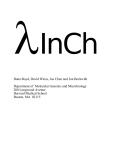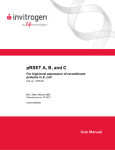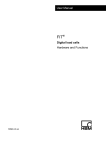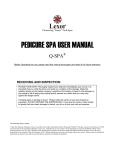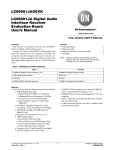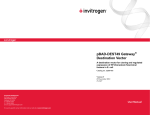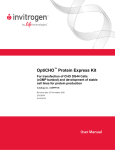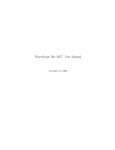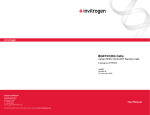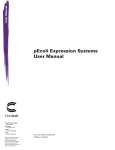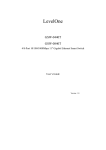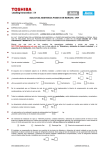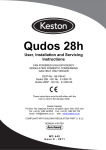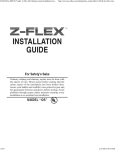Download pRSET/FP Vector - Thermo Fisher Scientific
Transcript
pRSET/CFP, pRSET/EmGFP, pRSET/BFP Vectors Catalog nos. V352-20, V353-20, V354-20 Rev. date: 14 December 2010 Manual part no. 25-0842 MAN0000519 Corporate Headquarters Invitrogen Corporation 1600 Faraday Avenue Carlsbad, CA 92008 T: 1 760 603 7200 F: 1 760 602 6500 E: [email protected] For country-specific contact information visit our web site at www.invitrogen.com User Manual ii Table of Contents Kit Contents and Storage ...........................................................................iv Introduction.................................................................................. 1 Product Overview ........................................................................................ 1 Methods ........................................................................................ 5 General Information .................................................................................... 5 Expression of Fluorescent Protein in E. coli .............................................. 6 Purification and Detection of Fluorescent Protein................................... 7 Appendix ...................................................................................... 8 pRSET/CFP, EmGFP and BFP Vectors ..................................................... 8 Recipes ......................................................................................................... 10 Accessory Products.................................................................................... 11 Technical Support ...................................................................................... 12 Purchaser Notification............................................................................... 14 References ................................................................................................... 17 iii Kit Contents and Storage Shipping and Storage pRSET vectors are shipped on wet ice. Upon receipt, store vectors at –20°C. Kit Contents All vectors are supplied as detailed below. Store the vectors at –20°C. Catalog no. Composition Amount V352-20 pRSET/CFP 20 L of 0.5 g/μL vector in 10 mM Tris-HCl, 1 mM EDTA, pH 8.0 10 g V353-20 pRSET/EmGFP 20 L of 0.5 g/μL vector in 10 mM Tris-HCl, 1 mM EDTA, pH 8.0 10 g V354-20 pRSET/BFP 20 L of 0.5 g/μL vector in 10 mM Tris-HCl, 1 mM EDTA, pH 8.0 10 g Intended Use iv Vector For research use only. Not intended for human or animal diagnostic or therapeutic uses. Introduction Product Overview pRSET/CFP, pRSET/EmGFP and pRSET/BFP Description of the System vectors are bacterial expression vectors that contain sequences encoding Fluorescent Proteins (FPs). FPs are derived from Green Fluorescent Protein, and contain amino acid substitutions that alter the spectral properties of the proteins (see page 3 for details). Upon excitation, these FPs emit a fluorescent signal corresponding to the colors cyan (CFP), emerald green (EmGFP) and blue (BFP). The FP sequences have been cloned into the bacterial expression vector pRSET A to produce pRSET/CFP, pRSET/EmGFP and pRSET/BFP. For a description of the major features of the vectors, see page 2. Applications The pRSET Fluorescent Vectors may be used as follows: Remove the Fluorescent Protein gene from the vector by restriction digest for cloning into a mammalian expression vector of choice to create a reporter vector, OR Express the Fluorescent Protein in E. coli, and detect and purify the protein for further study. Continued on next page 1 Product Overview, Continued Features of pRSET Fluorescent Vectors Features of the pRSET Fluorescent Vectors include: Bacteriophage T7 promoter for high-level, inducible expression of the Fluorescent Protein (FP) in E. coli Ribosome binding site (RBS) optimally spaced from Green Fluorescent Protein the initiation ATG for efficient translation of the FP N-terminal fusion peptide encoding: 6xHis tag for protein purification using metal binding resins Xpress epitope for detection of the expressed fusion protein using an Anti-Xpress antibody Enterokinase (EK) recognition site for efficient cleavage of the fusion peptide from the FP Fluorescent Protein derived from eGFP (CFP, EmGFP, BFP) Ampicillin resistance gene for selection in E. coli pUC origin for high-copy replication and maintenance of the plasmid in E. coli Green Fluorescent Protein (GFP) is a chemiluminescent protein originally isolated from the Aequorea victoria jellyfish (Shimomura et al., 1962). GFP is a useful biotechnology tool because the gene encoding GFP contains all necessary information for the posttranslational synthesis of the chromophore. GFP is widely used as a reporter, either when fused to a gene of interest or co-expressed in mammalian cells. The GFP fluorescence signal is easily detected using fluorescence microscopy and standard filter sets. Modifications have been made to wild-type GFP to enhance its expression in mammalian systems. These modifications include amino acid substitutions that: Change the spectral properties of the protein Optimize the codon usage for expression in mammalian cells, i.e., enhanced GFP (eGFP) (Zhang et al., 1996). Continued on next page 2 Product Overview, Continued Modified Fluorescent Proteins Fluorescent Proteins (FPs) that emit fluorescence signals at various wavelengths have been created by introducing amino acid substitutions in the eGFP protein. These mutations shift the spectral properties of the protein, resulting in cyan (CFP), emerald (EmGFP) or blue (BFP) detected fluorescence. Mutations in the FP genes of the pRSET Fluorescent Vectors have been described in a published review (Tsien, 1998) and are summarized in the table below. These mutations are represented by the single letter amino acid abbreviation corresponding to the codon number in the consensus sequence of eGFP followed by the single letter amino acid abbreviation for the substituted amino acid. Vector eGFP Mutations* pRSET/CFP K26R, Y66W, N146I, M153T, V163A, N164H pRSET/EmGFP F64L, S65T, S72A, N149K, M153T, I167T pRSET/BFP F64L, Y66H, Y145F, V163A, N198S *Mutations listed are as described in the literature. When examining the actual sequence, the vector codon numbering starts at the first amino acid after the initiation methionine of the FP, so that mutations appear to be increased by one position. For example, the F64L mutation actually occurs in codon 65 of the protein. Continued on next page 3 Product Overview, Continued Fluorescent Protein Spectral Properties Fluorescent Proteins can be detected using fluorescence microscopy or other methods that use light excitation and detection of emission. The table below lists the published excitation and emission wavelengths for CFP, EmGFP, and BFP (Tsien, 1998). All three FPs can be detected with standard FITC filter sets. However, for optimal detection of the fluorescence signal, you may want to use a filter set optimized for detection within the excitation and emission ranges for each FP. These filter sets are listed in the table below. Vector Excitation/ Filter Set for Emission Fluorescence (nm) Microscopy pRSET/CFP 452/505 Omega XF114 Chroma 31044 pRSET/EmGFP 487/509 Omega XF100 pRSET/BFP 308-383/ 440-447 Omega XF10 Chroma 31021 For information on obtaining filter sets, contact Omega Optical, Inc. (www.omegafilters.com) or Chroma Technology Corporation (www.chroma.com). 4 Methods General Information Applications You may use the pRSET Fluorescent Vectors for the following applications: Transfer the Fluorescent Protein gene into a mammalian vector of choice using restriction enzyme cloning. See below for guidelines. Express the Fluorescent Protein in E. coli and purify the protein. See page 7 for guidelines. E. coli Host for Vector Propagation To propagate and maintain pRSET Fluorescent Vectors, we recommend using a recA, endA strain such as One Shot TOP10F’ (see page 11 for ordering) or DH5. Select plasmid-containing transformants on LB plates containing 50-100 g/mL ampicillin. Plasmid Purification You may prepare plasmid DNA using your method of choice. We recommend using the PureLink™ HiPure Plasmid Purification Kit (see page 11). Transferring the FP Gene to Another Vector Each pRSET/FP Vector contains unique restriction sites flanking the FP gene to allow transfer of the FP gene to any vector of choice (e.g. mammalian expression vector) using restriction enzyme cloning. Refer to the vector map on page 8 to develop your cloning scheme. Note: If you clone the FP gene into a mammalian vector, remember to include a Kozak consensus sequence for proper translation initiation. If you are creating a fusion vector, remember to clone the FP gene in-frame with the gene of interest. Continued on next page 5 Expression of Fluorescent Protein in E. coli Introduction The pRSET Fluorescent Vectors allow expression of the Fluorescent Protein gene in E. coli under the control of the strong bacteriophage T7 promoter. The following section provides guidelines for choosing an appropriate E. coli strain for transformation of the pRSET Fluorescent Vector and for induction of Fluorescent Protein expression. We recommend that you maintain and propagate the Important plasmid in a recA, endA strain of E. coli such as TOP10 or DH5. Do not propagate your vector in a BL21 strain of E. coli. E. coli Host for Protein Expression In bacteriophage T7, the T7 promoter drives the expression of gene 10. T7 RNA polymerase recognizes this promoter. To express the Fluorescent Protein gene in E. coli, you may use a bacterial host that expresses T7 RNA polymerase or infect the cell with phage expressing T7 RNA polymerase. We suggest using a BL21-derived E. coli strain as the host for the expression construct. These strains express T7 RNA polymerase in a regulated manner. Induction of Protein Expression For isopropyl-D-thiogalactoside (IPTG) induction of protein expression, use a BL21-derived strain that contains the DE3 bacteriophage lysogen. The DE3 lysogen contains the T7 RNA polymerase under the control of the lacUV5 promoter, allowing expression of T7 RNA polymerase to be induced by IPTG. We recommend using BL21 Star(DE3) available from Invitrogen (see page 11) This strain contains the bacteriophage DE3 lysogen. Refer to the user manual for the strain you are using for detailed instructions on expressing protein. 6 Purification and Detection of Fluorescent Protein Introduction Once you have expressed the FP fusion protein, you may verify expression by simply holding the bacterial cell lysate under a UV light source to detect the fluorescent signal. Alternatively, you may perform western blot analysis to detect the fusion protein using the antibodies listed below. Guidelines for protein purification can also be found below. Detection Methods You may detect expression of your recombinant fusion protein by western blot using anti-Xpress™ and anti-GFP antibodies (see page 11). Purification Guidelines The presence of the polyhistidine (6xHis) tag in the fusion peptide of the Fluorescent Protein allows the use of a metal-chelating resin such as ProBond™ or Ni-NTA to purify your fusion protein. ProBond™ and Ni-NTA are available from Invitrogen (see page 11 for ordering). Refer to the manual included with each product for instructions to purify your 6xHis-tagged fusion protein. Note: Other metal-chelating resins and purification methods are suitable. Cleavage of the Fusion Peptide by Enterokinase The pRSET Fluorescent Vectors contain an Enterokinase (EK) recognition site to allow removal of the fusion tag from the expressed FP. We recommend using EnterokinaseMax from Invitrogen; see page 11 for ordering information. 7 Appendix pRSET/CFP, EmGFP and BFP Vectors The map below shows the features of pRSET/CFP, pRSET/EmGFP, and pRSET/BFP. Note that the vectors are identical in size, and only differ from one another in the sequence of the Fluorescent Protein gene. The vector sequence is available for downloading at www.invitrogen.com or by contacting Technical Support (page 12). Xho I Hind III BamH I EcoRI Nco I Map of pRSET Vectors ATG PT7 6xHis Xpress Epitope EK Fluorescent Protein TM Stop 1 f or i CFP, EmGFP, BFP 3.6 kb il l in pUC ori pRSET A ic mp Comments for pRSET/CFP, EmGFP and BFP 3600 nucleotides T7 promoter/priming site: bases 9-28 6xHis tag: bases 101-118 T7 gene 10 leader: bases 122-154 XpressTM epitope: bases 158-181 EK cleavage site: bases 167-181 Fluorescent Protein (CFP, EmGFP, BFP): bases 209-928 T7 reverse priming site: bases 987-1006 T7 transcription terminator: bases 948-1084 f1 origin: bases 1148-1603 bla promoter: bases 1635-1739 Ampicillin (bla) resistance gene: bases 1734-2594 pUC origin: bases 2739-3412 Continued on next page 8 pRSET/CFP, EmGFP, and BFP Vectors, Continued Features The pRSET/CFP, pRSET/EmGFP and pRSET/BFP vectors (3654 bp) contain the following elements. Elements have been functionally tested. Feature Function T7 promoter Provides tight, dose-dependent regulation of heterologous gene expression. T7 forward priming site Allows sequencing of the insert. Ribosome binding site (RBS) Optimally spaced from the cloning region for efficient translation of the gene of interest. Initiation ATG Provides a translational initiation site for the fusion protein. 6XHis Tag Permits purification of recombinant fusion protein on metal chelating resins such as ProBond and Ni-NTA. T7 gene 10 leader Provides protein stability. Xpress epitope Allows detection of the fusion protein using an anti-Xpress antibody. Enterokinase (EK) recognition site Provides a site for efficient removal of the fusion tag using EKMax. Fluorescent Protein (CFP, EmGFP or BFP) Modified fluorescent proteins derived from eGFP, whose expression results in the emission of fluorescent signal. T7 reverse priming site Allows sequencing of the insert. T7 terminator Permits efficient transcription termination. f1 origin Allows single strand rescue of DNA. bla promoter Allows expression of the ampicillin resistance gene. Ampicillin ORF Allows selection of the plasmid in E. coli. pUC origin Allows high copy replication and growth in E. coli. 9 Recipes LB Medium and Plates LB medium (1 Liter) 1. Dissolve 10 g tryptone, 5 g yeast extract, and 10 g NaCl in 950 mL deionized water. 2. Adjust the pH of the solution to 7.0 with NaOH and bring the volume up to 1 liter. 3. Autoclave on liquid cycle for 20 minutes. Allow solution to cool to ~55°C, and add antibiotic if needed. 4. Store at room temperature or at 4°C. LB agar plates 1. Prepare LB medium as described above, but add 15 g/L agar before autoclaving. Glycerol Stocks 2. Autoclave on liquid cycle for 20 minutes. 3. Allow agar to cool to ~55°C, and add antibiotic. Pour 20–30 mL agar into each 10 cm plate. 4. Let agar harden, then invert and store at 4°C, in the dark. 1. Streak a colony out for single colony isolation on LB plates containing the appropriate antibiotic. Isolate a single colony and inoculate into 1–2 mL of LB containing the appropriate antibiotic. Grow until culture reaches stationary phase. Mix 0.85 mL of culture with 0.15 mL of sterile glycerol and transfer to a cryovial. Store at –80°C. 2. 3. 4. 5. 10 Accessory Products The following products may be used with the pRSET vectors. For details, visit www.invitrogen.com or contact Technical Support (see page 12). Introduction Item Amount Catalog no. 6 × 2 mL precharged, prepacked ProBond™ resin columns and buffers for native and denaturing purification K850-01 50 mL R801-01 150 mL R801-15 6 × 20 rxns C665-24 20 × 50 L C3030-03 20 rxns C6010-03 PureLink™ HiPure Plasmid Miniprep Kit 100 preps K2100-03 PureLink™ HiPure Plasmid Midiprep Kit 25 preps K2100-04 EnterokinaseMax™ 250 units E180-01 Anti-Xpress Antibody 50 L R910-25 Anti-GFP (rabbit polyclonal) 100 L A11122 Anti-GFP (rabbit IgG conjugated to Alexa Fluor® 488) 100 L A21311 Anti-GFP (mouse monoclonal IgG) 100g A11120 ProBond™ Purification System ProBond™ Resin Electrocomp™ TOP10F´ ® One Shot TOP10F´ Chemically Competent E. coli BL21 Star(DE3) 11 Technical Support Web Resources Visit the Invitrogen website at www.invitrogen.com for: Technical resources, including manuals, vector maps and sequences, application notes, MSDSs, FAQs, formulations, citations, handbooks, etc. Complete technical support contact information Access to the Invitrogen Online Catalog Additional product information and special offers Corporate Headquarters: 5791 Van Allen Way Carlsbad, CA 92008 USA Tel: 1 760 603 7200 Tel (Toll Free): 1 800 955 6288 Fax: 1 760 602 6500 E-mail: tech_support@invitrogen. com Japanese Headquarters: LOOP-X Bldg. 6F 3-9-15, Kaigan Minato-ku, Tokyo 1080022 Tel: 81 3 5730 6509 Fax: 81 3 5730 6519 E-mail: [email protected] European Headquarters: Inchinnan Business Park 3 Fountain Drive Paisley PA4 9RF, UK Tel: +44 (0) 141 814 6100 Tech Fax: +44 (0) 141 814 6117 E-mail: [email protected] Certificate of Analysis The Certificate of Analysis provides detailed quality control and product qualification information for each product. Certificates of Analysis are available on our website. Go to www.invitrogen.com/support and search for the Certificate of Analysis by product lot number, which is printed on the box. SDS Safety Data Sheets (SDSs) are available on our website at www.invitrogen.com/sds. Continued on next page 12 Technical Support, Continued Limited Warranty Invitrogen (a part of Life Technologies Corporation) is committed to providing our customers with highquality goods and services. Our goal is to ensure that every customer is 100% satisfied with our products and our service. If you should have any questions or concerns about an Invitrogen product or service, contact our Technical Support Representatives. All Invitrogen products are warranted to perform according to specifications stated on the certificate of analysis. The Company will replace, free of charge, any product that does not meet those specifications. This warranty limits the Company’s liability to only the price of the product. No warranty is granted for products beyond their listed expiration date. No warranty is applicable unless all product components are stored in accordance with instructions. The Company reserves the right to select the method(s) used to analyze a product unless the Company agrees to a specified method in writing prior to acceptance of the order. Invitrogen makes every effort to ensure the accuracy of its publications, but realizes that the occasional typographical or other error is inevitable. Therefore the Company makes no warranty of any kind regarding the contents of any publications or documentation. If you discover an error in any of our publications, report it to our Technical Support Representatives. Life Technologies Corporation shall have no responsibility or liability for any special, incidental, indirect or consequential loss or damage whatsoever. The above limited warranty is sole and exclusive. No other warranty is made, whether expressed or implied, including any warranty of merchantability or fitness for a particular purpose. 13 Purchaser Notification Limited Use Label License No. 22: Vectors and Clones Encoding Histidine Hexamer This product is licensed under U.S. Patent Nos. 5,284,933 and 5,310,663 and foreign equivalents from Hoffmann-LaRoche, Inc., Nutley, NJ and/or Hoffmann-LaRoche Ltd., Basel, Switzerland and is provided only for use in research. Information about licenses for commercial use is available from QIAGEN GmbH, Max-Volmer-Str. 4, D-40724 Hilden, Germany. Limited Use Label License No 127: GFP with Heterologous Promoter This product and its use is the subject of one or more of U.S. Patent Nos. 5,491,084 and 6,146,826, and foreign equivalents. This product is sold under license from Columbia University. Rights to use this product are limited to research use only, and expressly exclude the right to manufacture, use, sell or lease this product for use for measuring the level of toxicity for chemical agents and environmental samples in cells and transgenic animals. No other rights are conveyed. Not for human use or use in diagnostic or therapeutic procedures. Inquiry into the availability of a license to broader rights or the use of this product for commercial purposes should be directed to Columbia Innovation Enterprise, Columbia University, Engineering Terrace-Suite 363, New York, New York 10027. Continued on next page 14 Purchaser Notification, Continued Limited Use Label License No. 198: Fluorescent Proteins and Stable Cell Lines Expressing Such Proteins (but not for vectors that contain the genes for such fluorescent proteins) This product and its use is the subject of one or more of U.S. Patent Nos. 5,777,079, 6,066,476, and 6,319,669 and foreign equivalents. The purchase of this product conveys to the buyer the nontransferable right to use the purchased amount of the product and components of the product in research conducted by the buyer (whether the buyer is an academic or for profit entity). No rights are conveyed to modify or clone the gene encoding GFP contained in this product. The buyer cannot sell or otherwise transfer (a) this product, (b) its components, or (c) materials made by the employment of this product or its components to a third party or otherwise use this product or its components or materials made by the employment of this product or its components for Commercial Purposes. The buyer may transfer information or materials made through the employment of this product to a scientific collaborator, provided that such transfer is not for any Commercial Purpose, and that such collaborator agrees in writing (a) not to transfer such materials to any third party, and (b) to use such transferred materials and/or information solely for research and not for Commercial Purposes. Commercial Purposes means any activity by a party for consideration and may include, but is not limited to: (1) use of the product or its components in manufacturing; (2) use of the product or its components to provide a service, information, or data; (3) use of the product or its components for therapeutic, diagnostic or prophylactic purposes; or (4) resale of the product or its components, whether or not such product or its components are resold for use in research. Life Technologies Corporation will not assert a claim against the buyer of infringement of the above patents based upon the manufacture, use or sale of a therapeutic, clinical diagnostic, vaccine or prophylactic product developed in research by the buyer in which this product or its components was employed, provided that none of this product, or any of its components was used in the manufacture of such product. If the purchaser is not willing to accept the limitations of this limited use statement, Life Technologies Corporation is willing to accept return of the product with a full refund. For information on purchasing a license to use this product for purposes other than those permitted above, contact Licensing Department, Life Technologies Corporation, 5791 Van Allen Way, Carlsbad, California 92008. Phone (760) 603-7200 or [email protected]. Continued on next page 15 Purchaser Notification, Continued Limited Use Label License No 267: Mutant Green Fluorescent Products This product and its use is the subject of one or more of U.S. Patent Nos. 6,090,919, 5,804,387, 5,994,077, and foreign equivalents. Limited Use Label License No 268: Green Fluorescent Proteins This product is licensed from Amersham Biosciences UK Ltd. under U.S. Patent Nos. 6,172,188 and 6,818,443 and foreign equivalents, and is provided only for discovery and development of human therapeutics (e.g. small molecules or proteins), including clinical trials, but excluding, without limitation, agrochemistry, diagnostics, environmental, veterinary and consumer product applications (such as flavors, fragrances and taste enhancers). Limited Use Label License No 358: Research Use Only The purchase of this product conveys to the purchaser the limited, non-transferable right to use the purchased amount of the product only to perform internal research for the sole benefit of the purchaser. No right to resell this product or any of its components is conveyed expressly, by implication, or by estoppel. This product is for internal research purposes only and is not for use in commercial applications of any kind, including, without limitation, quality control and commercial services such as reporting the results of purchaser’s activities for a fee or other form of consideration. For information on obtaining additional rights, please contact [email protected] or Out Licensing, Life Technologies, 5791 Van Allen Way, Carlsbad, California 92008. 16 References Shimomura, O., Johnson, F. H., and Saiga, Y. (1962) Extraction, Purification and Properties of Aequorin, a Bioluminescent Protein from the Luminous hHydromedusan, Aequorea. Journal of Cellular and Comparative Physiology 59, 223-239 Tsien, R. Y. (1998) The Green Fluorescent Protein. Annu. Rev. Biochem. 67, 509-544 Zhang, G., Gurtu, V., and Kain, S. (1996) An Enhanced Green Fluorescent Protein Allows Sensitive Detection of Gene Transfer in Mammalian Cells. Biochem. Biophys. Res. Comm. 227, 707-711 ©2009, 2010 Life Technologies Corporation. All rights reserved. 17 Notes 18 Corporate Headquarters 5791 Van Allen Way Carlsbad, CA 92008 T: 1 760 603 7200 F: 1 760 602 6500 E: [email protected] For country-specific contact information, visit our web site at www.invitrogen.com User Manual

























